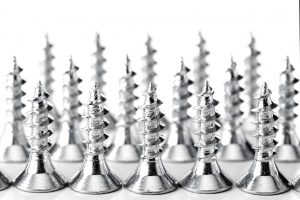 Fasteners come not only in a wide array of shapes, materials, and sizes, they also come in a variety of plated or coated finishes. The reason for this is not just aesthetic – fasteners are the one product that comes in contact with an equally wide range of dissimilar metals that can cause various reactions, including corrosion. For this reason, most engineers will recommend that fasteners be plated or coated with a material that combats the negative effects of dissimilar metal contact.
Fasteners come not only in a wide array of shapes, materials, and sizes, they also come in a variety of plated or coated finishes. The reason for this is not just aesthetic – fasteners are the one product that comes in contact with an equally wide range of dissimilar metals that can cause various reactions, including corrosion. For this reason, most engineers will recommend that fasteners be plated or coated with a material that combats the negative effects of dissimilar metal contact.
Because there are many options for plating and finishing, let’s start with the four most popular types which address most of the common concerns with corrosion, including levels of resistance, cost-efficiency, and longevity:
Zinc plating: This is perhaps one of the least expensive and most common fastener finishes. A thin coat of zinc is applied to the fastener through either electroplating or simple painting. It produces an attractive silver fastener resists corrosion and looks good. To make the coating harder, the coating can also be treated with chrome through a process known as chemical chromate passivation.
Galvanizing: Technically another form of zinc plating, this process involves dipping fasteners into molten zinc and then running them through a centrifuge to spin off any excess zinc. Plating provides a thicker coating for more protection against corrosion, but the thin coat produced by galvanizing may be more attractive and appropriate for some applications.
Phosphate coating: This process is not typically used for coating most fasteners because it doesn’t offer as much corrosion-resistance as other processes. However, it acts as a good base for applying paint to fasteners, which may make it a better choice for products getting a coat of paint that needs to be matched.
Cadmium plating: This process has been largely replaced by zinc plating because cadmium has less environmentally-friendly properties. However, in applications where better corrosion resistance is necessary and other properties are required, such as better lubricity and excellent adhesion, cadmium is still preferred.
Some other popular coating considerations include:
Anodizing: An acid dip used on aluminum only that gives it a frosty, etched appearance. It provides excellent corrosion resistance and parts can be color-dipped after being anodized.
Black oxide: is a chemical treatment that gives ferrous metal and stainless steel parts a black finish. It does not add thickness to parts, nor does it provide corrosion resistance. Parts usually undergo an oil dip after being treated, and the oil dip adds a significant amount of corrosion resistance.
Chromium produces a hard, lustrous, bright blue or white finish that provides wear and corrosion resistance for all metals — however, it’s expensive.
Nickel is a hard, stable, and relatively expensive finish with good corrosion protection that produces a silver color on all metals — however, it can be difficult to apply.
Plating and coating not only prolongs the life of the fasteners, in some cases it also makes using them a lot easier and adds a pleasing aesthetic to many products that benefit from a more attractive retail consumer or commercial appearance. To learn more about the right coating for your fasteners, contact the plating and coating specialists here at Electronic Fasteners.
